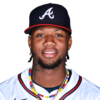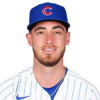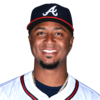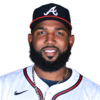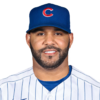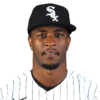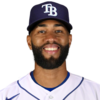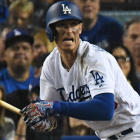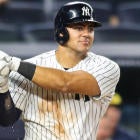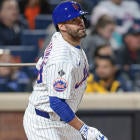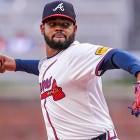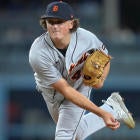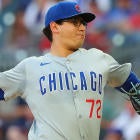For more Fantasy baseball insights, and to keep up with all the latest news, roster trends, and more throughout the season, subscribe to Fantasy Baseball Today now on iTunes, Stitcher, or Spotify. You can find us on YouTube now, with full episodes and clips available every Monday through Friday.
Overrated. It's kind of a trigger word, isn't it?
Look, it's not that I hate any of these players. In fact, some I'd really like to like. But they're all going so much earlier than I'd feel comfortable taking them, at least comparing my own ranking to FantasyPros ADP.
Usually it's because the risk isn't fully accounted for or there are just better options at that stage of the draft. But I address them all one by one. Hopefully, you can see where I'm coming from.
Note that where each player ranks, whether it's by ADP, my own rankings or Heath Cummings', refers to Rotisserie value, but rest assured, I also venture into points-league discussion. Note also that while I tried to exclude the players already mentioned in my Busts column, I'm only human and have a couple of duplicates.
12 is a big number!
The problem with Ronald Acuna's ADP is it assumes just a little too much. It assumes his final 68 games, when he hit .322 with 19 homers and a 1.028 OPS, were more indicative than his first 43, when he hit .249 with seven homers and a .742 OPS. And maybe they were, in the strictest sense, but they also depended on a .367 BABIP and 25.3 percent home run-to-fly ball rate — outlier ratios that we'd normally know better than to trust over a small sample. It also assumes he's going to run more like he did in the minors, but 88 percent of his steals last year came out of the leadoff spot even though only 62 percent of his plate appearances did. And, news flash, manager Brian Snitker is leaning toward batting him cleanup this year.
Look, Acuna is great, and I'd be hard-pressed to classify him as a bust, which is why I haven't. The absolute floor is something like Justin Upton, I think. But when you're talking about him in the first round, going up against one proven super-stud after another, I don't see why we have to anoint him to that level yet. Seems like there's more to lose than gain by doing so.
I get it. Walker Buehler had a 1.55 ERA, 0.85 WHIP and 10.4 strikeouts per nine innings over his final 12 starts, throwing six innings or more in 10 of them, and it may well have been an ace turn for a pitcher presumed to have ace upside. But in this new pitching landscape, with all the limits and roadblocks put in place for developing arms, I have a simple rule regarding prospective aces: If they haven't done it before, you can't assume they will.
The "it" I'm referring to is pairing elite ratios with elite workload, and for Buehler, as for most up-and-coming pitchers, it's obviously the workload that concerns me. For that 12-start stretch, yeah, he had a good pace, but can he sustain it for a whole season? Will the Dodgers let him after already seeing his innings jump from 98 two years ago to 177 last year. It was a reckless increase, no doubt provoked by their playoff run, and given the way they've slow-played him this spring, I have my doubts it goes up from there.
Which isn't to say you shouldn't draft him early — I rank him inside my top 50 overall, after all — but ahead of Patrick Corbin and Zack Greinke, a couple of pitchers who have already done it (one of them routinely) is too big of a leap for me.
Understand first of all that Cody Bellinger was only the 63rd-best player in Rotisserie leagues and the 72nd-best in Head-to-Head points last year, so while his ADP may not fully account for his upside, the risk is less than fully baked in. Considerably less.
Because consider the other wrinkle: Bellinger hit .226 with a .681 OPS against left-handed pitchers last year. The Dodgers are among the most platoon-friendly clubs and will again place a high priority on playing Chris Taylor, Enrique Hernandez and David Freese against left-handed pitchers. Bellinger was one of the biggest victims of those platoons down the stretch, starting against just one of the seven lefties the Dodgers faced over the final two weeks. Even if that's not the plan for him going into this year, you can see how he'd wind up there again. And in that scenario, even if his power production is back in line with his batted-ball profile, you may have a hard time starting him in leagues that use weekly lineups.
It's a lower-probability outcome, of course, but it's a plausible-enough scenario that's being too widely dismissed.
I'm not totally down on Ozzie Albies, acknowledging that the totality of his production was awfully impressive, if not historic, for a 21-year-old middle infielder. But boy, was it front-loaded. He hit nine home runs in the first month, five in the second and then a combined 10 over the final four. And it's not like he made up for it in other ways. Nope, it was one big nasty spiral into the abyss. The steals weren't totally absent, but 14 wasn't the total we had in mind going in, and for striking out so infrequently, his batting average left much to be desired, probably because he was so power-focused.
So clearly, there are things to work on. There's also plenty to work with, which is why I rank him as high as I do, but entrusting him with a pick that could go to a player much more established with possibly even more upside, like a Joey Votto or Greinke, doesn't add up to me, especially knowing that Scooter Gennett and Robinson Cano will be out there later.
As with Albies, it's fair to assume we haven't seen the best of Gleyber Torres yet, given both his pedigree and how quickly he acclimated himself to the majors. But there are still some stud bats left at 58th overall, as well as pitchers with ace potential. Passing them up for another 25-homer infielder — which, let's face it, are a dime a dozen in today's power-laden environment — is foolhardy.
And that's all Torres showed the ability to do as a rookie: hit some homers. It's useful, of course, but the batted-ball profile was virtually identical to Paul DeJong's, and the Cardinals shortstop is only going 179th overall. In Head-to-Head points per game, Torres was outclassed by both Eduardo Escobar and Jorge Polanco, so I tend to think my ranking is generous, accounting for plenty we haven't seen yet. But I guess there's no competing with the two-pronged hype monster that is a highly regarded Yankees prospect.
What's wild to me is how people are drafting Kenley Jansen like last year never happened. Yeah, he pulled a rabbit out of his hat over the long haul, redeeming what was a disastrous April, but it doesn't mean he was back to being the elite closer he's still being drafted to be. His velocity was still down, and his K/9 and swinging-strike rate were both way down. They weren't bad, per se, but he went from being an other-worldly closer to just another closer.
And that was the result of basically a 1 mph difference in average velocity, which would suggest he's on a slippery slope here in terms of skills decline. His velocity has come into question again this spring, which somewhat addresses the counterargument that he just wasn't healthy last year (a fact that can't be ignored). But mostly, it provokes feelings of "here we go again," particularly among those who feel like they dodged a bullet last year. Bottom line is he should come at a discount, and he doesn't, going seven spots after Blake Treinen on average and one after Aroldis Chapman. And plenty of closers thereafter are safer.
Clearly the impact of that 2017 season, when Marcell Ozuna hit .312 with 37 homers and a .924 OPS, still looms large, but I'm not sure it was ever a realistic outcome for him given that it depended on both an outlier BABIP and an outlier home run-to-fly ball rate. Both returned to career norms last year, which may on its own explain the drop in production.
But there are those who would point to the fact Ozuna was much better over the final four months, batting .290 with 20 homers, to which I'd say, "Yes, but with only an .816 OPS and a point-per-game average that would have been on the level of Nicholas Castellanos if he had sustained it over a full season." Then there are those who would point to the fact he played all of last year with a bad shoulder, which eventually required surgery, to which I'd say, "Yes, but now he's coming off shoulder surgery and, by the way, acknowledged that the shoulder hadn't felt right for three years."
Mostly, though, I keep going back to the unsustainability of those 2017 numbers and wonder how anyone could justify taking Ozuna a spot ahead of Jose Abreu, as their ADP shows. I view him as more like a No. 3 outfielder with the upside of a No. 2.
I need speed as much as the next guy, so I can understand the appeal of Villar, who swiped 21 bases in 54 games after joining the Orioles last year and has a history of being a surprise contributor in Fantasy. But if a player has more than one documented case of being a surprise contributor in Fantasy, it means things went way wrong at one point, and that point was 2017.
True, the circumstances were a little different. Villar was being drafted as early as Round 3 (ew) following a 19-homer, 62-steal season, and the contending Brewers couldn't afford to wait him out as much as these rebuilding Orioles can. But Villar isn't a long-term asset for them. If he isn't proving his worth as a trade chip, he might still lose his grip on everyday duty, and if he is, well, he could find himself traded into a bench role. Mostly, though, it's the fact that his high-whiff, high-ground ball profile is too volatile for a seventh-round price tag, especially given his history of wide-ranging production.
Kyle Hendricks ranked 47th among the 58 qualifying pitchers in K/9 last year, which isn't a deal-breaker in and of itself, but it's a major disadvantage at a time when strikeouts are being recorded at record numbers. Yeah, he throws strikes and doesn't have major home run issues thanks to his ground-ball tendencies, but he's not anywhere near Miles Mikolas level in either of those areas. The fact he has greatly outperformed his FIP three years running suggests he's playing with fire.
Contrast him to Chris Archer, who has consistently underperformed his FIP while ranking among the league leaders in strikeouts, and there's really no justification for taking Hendricks one spot ahead. You want Hendricks production? Look to Marco Gonzales about 100 picks later.
Tim Anderson was one of just 10 players to contribute at least 20 homers and 20 steals last year, which makes him useful, but it's pretty much the full extent of his contributions. You'd need to be hard up for steals to take that kind of hit at a point in the draft where so many interesting pitchers, closers and otherwise, are flying off the board. And if that's the case, why not just take Billy Hamilton, who's liable to provide twice as many steals a full two rounds later?
Plus, just look at the other middle infielders going in that same range. Brian Dozier was a third-round pick last year and could bounce back in a big way with a return to full health. And hey, for as bad as he was in 2018, he still stole a dozen bases. Jurickson Profar himself flashes 20-20 potential, along with bat skills that are on the opposite end of the spectrum from Anderson. Why pass up that kind of upside for known mediocrity?
Amed Rosario picked up 15 of his 24 stolen bases over the final two months last year, which is about the point when the Mets moved him to the leadoff spot. But his success rate stealing bases wasn't so great, and, oh yeah, there's no way he's batting leadoff again with everything the Mets have added to their lineup this offseason.
He's not a good enough hitter to justify it. Sure, he also batted .284 over those two months, but with pitiful on-base skills and virtually no power. In fact, the batted ball data suggests he had to trade off what little power he had just to hit .280, which is all kinds of discouraging. Will he be as aggressive on the base paths if he's batting eighth? History would suggest he won't, and if he's not making a significant impact in that category, he's on a quick path to dropsville.
As a rookie last year, Harrison Bader showed some power and some base-stealing ability. It wasn't a ton of either, but to fill a fifth outfield spot in a Rotisserie league, just the possibility of a 20-20 performer is hard to pass up. Problem is he's going in more like the third or fourth outfielder range, ahead of some really upside-y types like Byron Buxton and Jesse Winker. And if you compare it to some of the other positions, Luke Voit and Danny Jansen are going just a little bit later, as well as Jon Gray among starting pitchers. They all have question marks, sure, but in the context of a mixed league, say 12 teams or fewer, you'd rather gamble on the upside than settle for safe at this stage of the draft.
And Bader is safe mostly because his defense all but guarantees him full-time at-bats and he won't be a complete zero for stolen bases. There are significant contact issues, though — he needed a .358 BABIP just to hit .264 last year — and his power isn't exactly first-rate. The complete package is a little reminiscent of Kevin Kiermaier, who always seems like a better pick in theory than in reality, and the production will quite possibly be matched in the late late rounds by either Ramon Laureano or Kiermaier himself.
So which Fantasy Baseball sleepers should you snatch in your draft? And which undervalued pitchers can help you win a championship? Visit SportsLine now to get Fantasy Baseball rankings for every single position, all from the model that called Scooter Gennett's huge breakout last season, and find out.







